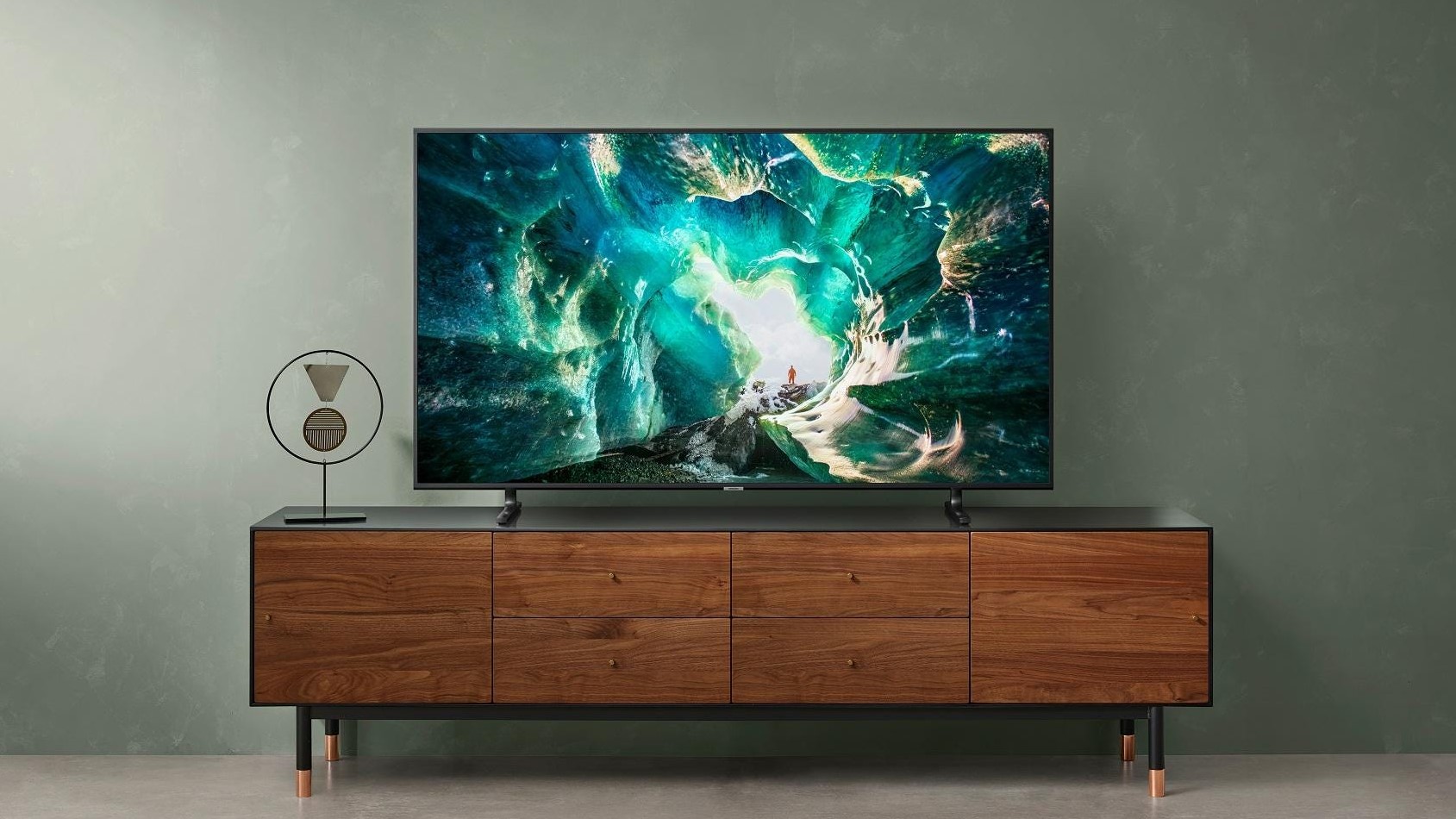TechRadar Verdict
The Samsung RU8000 series offers up plenty of bang for your buck thanks to its impressively comprehensive smart system and user-friendly interface - including Bixby voice control. Forgoing QLED technology does cost the RU8000 a fair chunk of brightness and color range. Strangely, though, it turns out this isn’t as bad a thing as it sounds.
Pros
- +
Excellent value
- +
Good picture quality
- +
Impressive smart TV platform
- +
HDR10+ support
Cons
- -
Slightly flimsy build quality
- -
Limited viewing angles
- -
Occasional black level issues
- -
No Dolby Vision support
Why you can trust TechRadar
While there’s no doubt that Samsung’s ‘QLED’ Quantum Dot technology delivers a premium experience, it also comes with a premium price tag attached.
So it’s great to find that Samsung can also combine plenty of picture quality with a great smart system even when you step down to a non-QLED series like the RU8000. These use regular color filters, are illuminated by less aggressive backlight systems and, as a result, are far more affordable.
But the question is, can it combine value and performance well enough to justify its existence, or does it fall awkwardly between the price and performance stools?
- New Samsung TV: all the latest screens
Price and release date
The Samsung RU8000 is Samsung's 2019 mid-range topper and comes in five screen sizes including a 49-inch, 55-inch, 65-inch, 75-inch and (in the US) a monstrous 82-inch version.
In the US, pricing starts at $599.99 for the 49-inch UN49RU8000 while the 82-inch UN82RU8000 only costs around $1,000 more ($1,799 to be exact). In between, you've got the $649 55-inch Samsung UN55RU8000 (reviewed here), the $899 65-inch Samsung UN65RU8000 and $1,299 75-inch Samsung UN75RU8000.
In the UK, you'll have fewer options than in the US, but you'll still be able to pick between a 49-inch, 55-inch and 65-inch version that will run you £549, £599 or £749, respectively.
Last but not least, Australia has three RU8000 models to pick from - the 55-inch, 54-inch and 82-inch screens - that cost AU$1,599, AU$2,299 and AU$4,699, respectively.
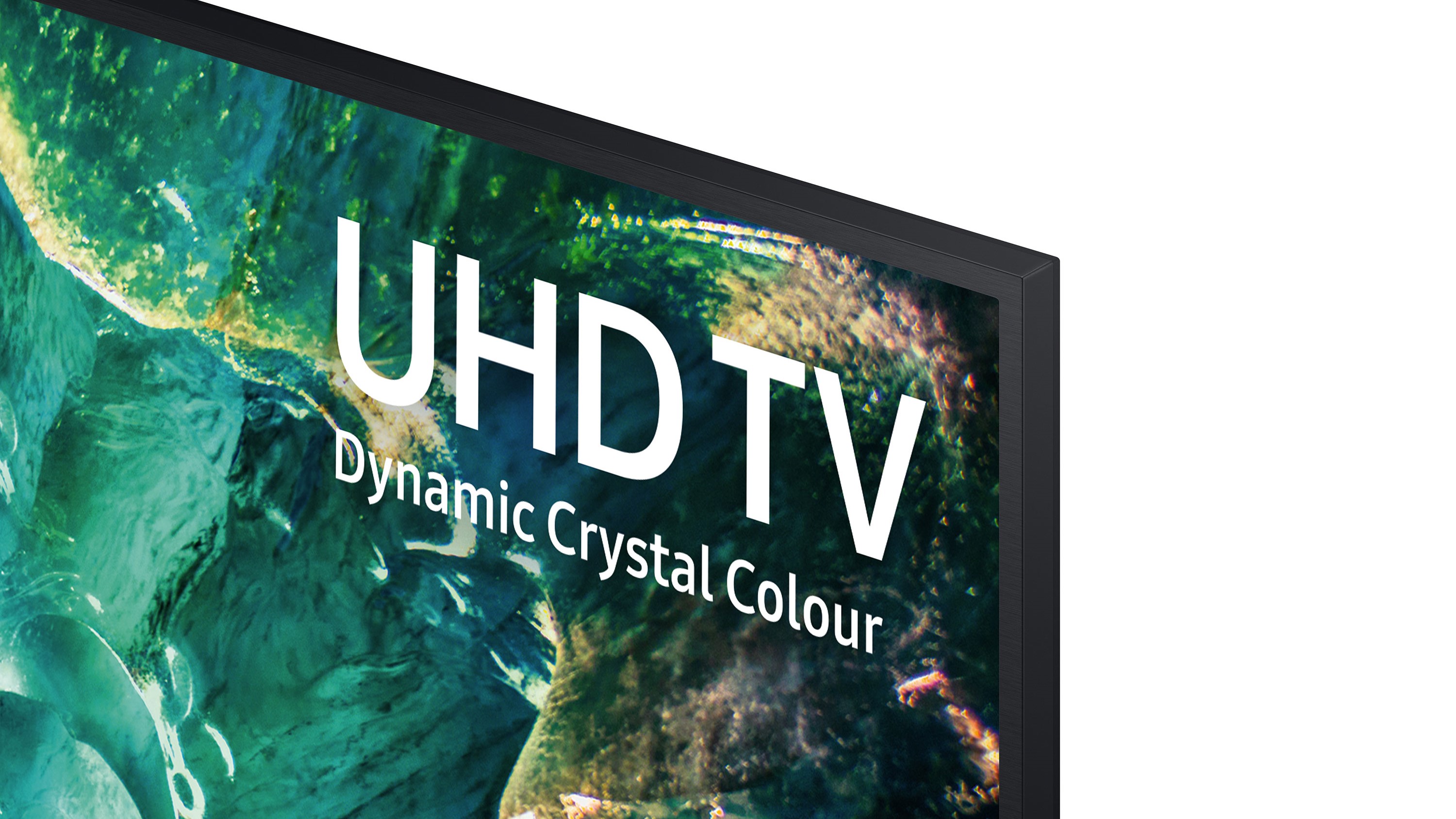
Design
The RU8000 isn’t particularly glamorous by Samsung standards - its screen frame looks and feels pretty plasticky, and it feels strikingly lightweight while you’re setting it up. Its desktop feet are a flare-free zone, too. And because they attach towards the TV’s bottom left and right corners, you’ll also need a pretty wide table or TV stand to sit the TV on.
The good news it that, while it’s not as thin round the back as some of today’s LCD or, especially, OLED TVs, it’s certainly not a ‘budget fatty’. And while its bezel might not be especially robustly built, it is at least pretty narrow, meaning it doesn’t distract you much from the RU8000’s all-important pictures.
Impressively for its money, the 55-inch 55RU8000 carries four HDMIs, all capable of handling 4K and HDR. There are a pair of USBs for multimedia duties too, as well as built-in Wi-Fi and Bluetooth support. Just note that if you’re expecting to use headphones with the RU8000, there’s no hard headphone connection - you’ll need a pair of Bluetooth headphones instead.
Design TL;DR: It’s a bit lightweight and flimsy, and sits on two of the most basic-looking feet we’ve seen. It’s decently trim around its back and edges, though, and its connections include a handy four HDMIs.
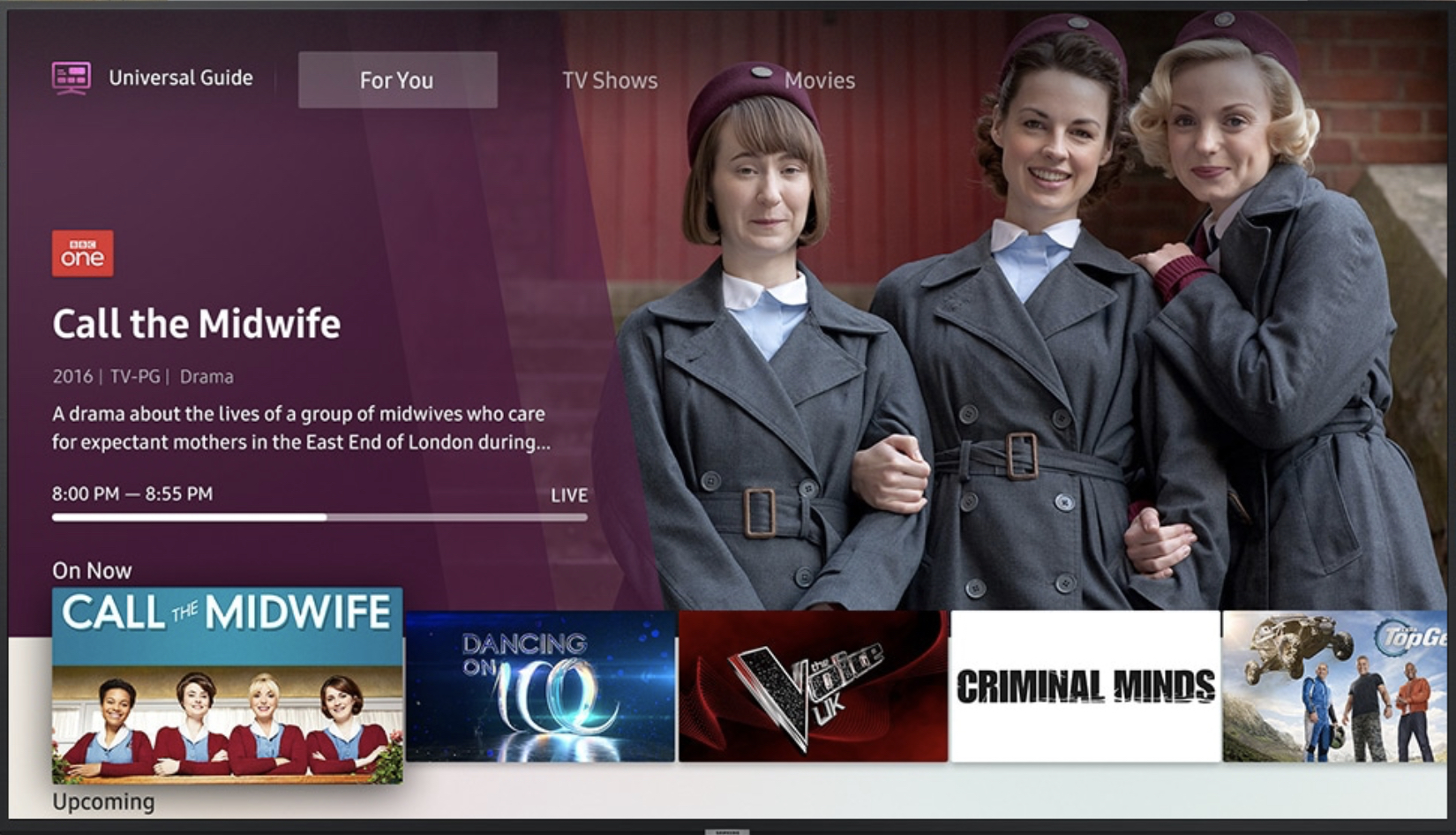
Smart TV (Tizen Eden 2.0)
The Samsung RU8000 gets the same Tizen-based Eden 2.0 smart platform sported by the Korean brand’s premium 2019 QLED models.
This gives you a simple, space-saving home screen comprising a tidy row of link icons along the bottom of the screen. An upper layer of direct content link sometimes pops up if the app you’ve chosen on the bottom deck supports it.
You can easily rearrange the running order of the icons to keep your favorites at the start, and Samsung’s Bixby voice control lets you issue search terms and operational commands just by talking into your remote. You can also use Amazon Alexa, but only if you have an external Alexa listening device.
Samsung’s smart platform supports an extremely long list of apps: Smart TV regulars such as Netflix, YouTube, Amazon Prime Video, Rakuten and all the main UK terrestrial broadcaster catch-up apps are joined by Chili (which is promising 8K content) and the Apple TV app. This provides access to the Apple TV+ service, as well as the Apple ‘iTunes’ library of movies and TV shows.
All content from every video app plays in 4K and HDR where available. Though since Samsung still refuses to support Dolby Vision, the HDR playback only covers the HDR10, HDR10+ and HLG formats.
The only missing app of significance is Freeview Play, meaning that while all the key UK broadcaster catchup services are provided, you can’t see them all brought together under Freeview Play’s handy ‘umbrella’ interface.
The Samsung RU8000’s smart system only has a Quad Core processor behind it, rather than the more powerful engines found in some of Samsung’s premium TVs. But it still ran decently slickly and stably during our tests.
Smart TV TL;DR: Samsung’s latest smart platform puts vast amounts of content at your fingertips while occupying minimal screen real estate.
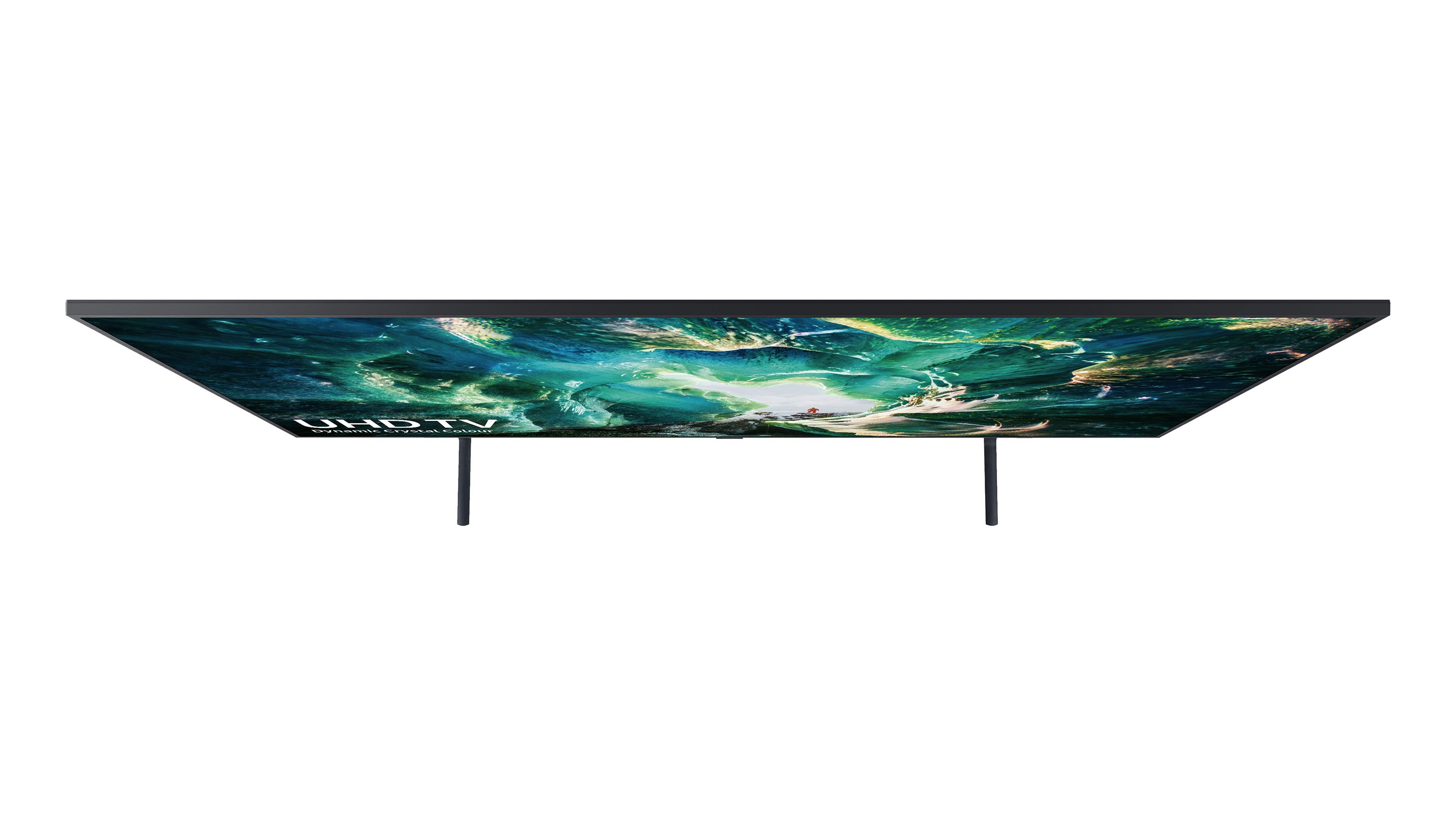
HD/SDR Performance
The Samsung RU8000 is almost effortlessly good at handling the HD and standard dynamic range content most households still spend most of their time watching.
Its ‘UHD Processor’ does a good job of converting HD’s 1920x1080 resolution into the screen’s 3840x2160 pixel count. With decent quality HD sources, at least, there’s a real sense of added detail, and the results look sharp and clear without, typically, any exaggeration of source noise.
Just occasionally a particularly grainy HD source can look a touch ‘fizzy’ using the default settings provided by the Standard picture preset (which is the preset we’d recommend most people stick with). But where this issue arises it’s easily remedied by nudging down the sharpness setting a couple of levels. We’d recommend this ‘fix’ over using the set’s noise reduction, by the way, as the NR can cause the image to look slightly soft and processed.
The RU8000’s upscaling is less comfortable with SD-resolution and poor-quality HD sources such as heavily compressed digital broadcasts. These tend to look quite soft and exhibit a little color shifting at times. But they’re still perfectly watchable - more so, in fact, than on the majority of similarly affordable 4K TVs out there.
A combination of strikingly good black levels and color finesse for its price point make the RU8000 an excellent handler of standard dynamic range sources. Dark scenes on an array of favorite Blu-rays look unfailingly convincing, with deep black colors appearing alongside decently punchy bright highlights.
Bright SDR scenes look equally compelling, though. Rich, full colors combine with impressively subtle light control to deliver an impressive array of tones and shades that leave pictures looking lifelike and three dimensional.
SDR skin tones enjoy enough tonal subtlety to avoid the plasticky look sometimes seen on such affordable LCD TVs, and there’s no hint of common budget TV problems like colour banding or gaudiness.
Just occasionally very dark areas of the picture can lose a bit of subtle shadow detail, leaving them looking slightly hollow. But this is much easier to live with than the higher levels of greyness over dark areas that so many other similarly affordable LCD TVs suffer with.
Even the sharp, detailed look of upscaled HD pictures noted earlier owes a debt of gratitude to the UE55RU8000’s colour and light management, as it helps to ‘sell’ the impact of all those extra pixels of picture information Samsung’s processors are conjuring up.
Also worth noting, finally, is that Samsung’s upscaling processing and colour management is so good that the sense of sharpness and clarity holds up very nicely when there’s motion in the image.
HD/SDR Performance TL;DR: The Samsung RU8000 handles HD and SDR images pretty brilliantly for its money.
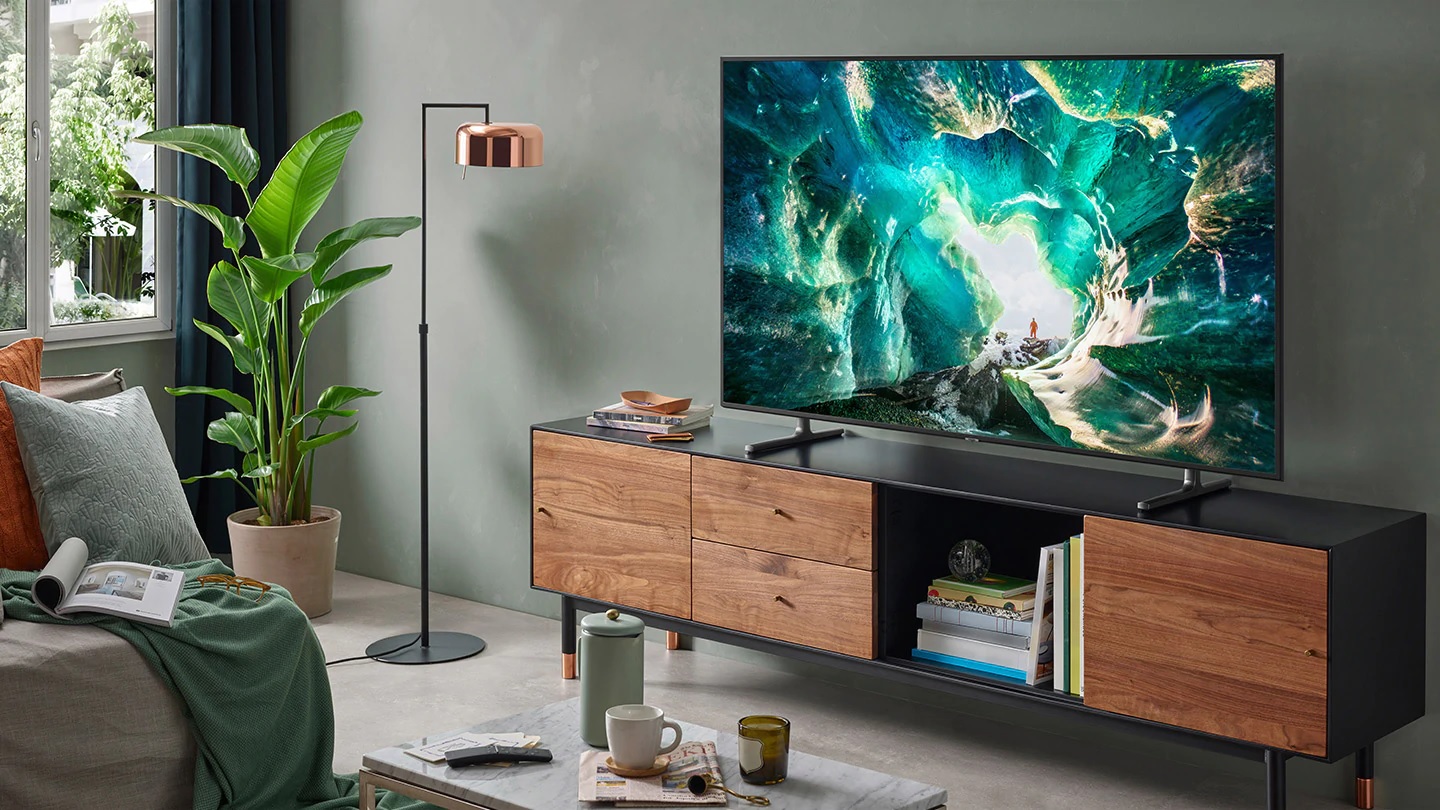
4K/HDR Performance
The sharpness that was so apparent with upscaled HD pictures on the Samsung RU8000 serves it even better with native 4K images. In fact, the difference between HD and 4K is unusually pronounced for such an affordable TV.
The extreme clarity and sharpness of native 4K pictures also underlines how well the RU8000 handles motion, as there’s strikingly little interference from judder, or LCD’s blurring problem... just make sure that you choose the Custom motion option, and set the judder and blur elements to around three or four each. (Samsung’s default Auto motion setting tends to be a bit heavy handed, resulting in some obvious unwanted side effects - smearing and double rendering of small objects, for instance.)
The RU8000 succeeds when it comes to showing HDR, too - though this success is, inevitably for the set’s money, a little more tempered: we only managed to get a peak brightness measurement of around 360 nits out of the RU8000 (based on playback of a white HDR window covering 10% of the screen area). By comparison, the Q60R, the cheapest of Samsung’s QLED models, musters nearly 600 nits.
This is, on paper at least, a big deal where HDR is concerned. Certainly there is no doubt that the RU8000 can’t look as bright with light HDR content as the Q60R. Nor do the brightest HDR peaks look as radiant and lifelike on the cheaper models.
Similarly, while the RU8000 does get wide color support (to the tune of more than a billion promised shades) courtesy of Samsung’s so-called Dynamic Crystal Color system, it can’t produce the same color volumes as its QLED siblings. Again, this limits its potential to do full justice to everything that HDR (and its attendant wide color technology) has to offer.
Within these limitations, though, the RU8000 really does do HDR pretty well. For instance, full-on bright HDR shots sustain their brightness with an intensity that belies the measured 350 nits of peak light output. Colors, too, look rich and typically convincing, even though they’re never able to be benefit from the same levels of brightness you can get from Samsung’s Q60R.
In fact, the RU8000’s colors often look more convincing than those of the Q60R sets. Mostly because the 55RU8000’s relatively muted brightness actually seems a better fit for its color reach, so that it typically avoids the slightly washed out look some Q60R tones exhibit.
The RU8000’s relatively unambitious brightness levels also likely contribute to its often impressive black level performance with HDR sources. So much so, in fact, that it's hard to think of any other TV in the RU8000’s price bracket that’s capable of delivering blacks as deep and convincing when showing HDR content.
Black levels take a hit if you’re watching an HDR image that contains a real mix of bright and dark content (stuff like night-time cityscapes). But this is pretty much inevitable with any TV which, like the RU8000, uses edge LED lighting with no local dimming. As pretty much every TV in its price range does. The difference is that precious few other TVs for the same sort of money can do good black levels when an HDR shot is predominantly dark.
The bad news? The RU8000’s impressive contrast and color performance is reduced if you have to watch it from much of an angle. If this is an issue for your room set up, then you may need to think about getting a TV that uses IPS technology instead of the VA technology used by the RU8000. Though bear in mind that IPS panels are no match for VA ones when it comes to contrast.
4K/HDR Performance TL;DR: The RU8000’s native 4K pictures look exceptionally sharp and detailed. Its HDR is inevitably limited in scope, but within those limitations it manages to deliver a well-rounded and engaging HDR experience.
Sound
The RU8000 is about average on the audio front. On the upside its sound is pretty clean and detailed, and doesn’t sound excessively brittle during loud action scenes. The sound is also cast away from the screen quite effectively, giving it more room-filling presence than you typically hear with such affordable TVs.
Vocals tend to be convincing and clean, and it’s a relief to find that while the Samsung RU8000’s bodywork is pretty flimsy, it doesn’t succumb to rattling or buzzing interference.
On the downside, there isn’t a great deal of depth or presence to its bass, and the presentation tends to stay pretty flat, neither opening up for loud moments, nor adopting a subtler tone for quieter scenes.
Sound TL;DR: The RU8000’s audio is nothing to get excited about - but it doesn’t do anything badly wrong, either.
Verdict
Looking at the specs you might assume that the RU8000 can't justify its position between the stellar value of the impressive Samsung RU7470 series and Samsung’s brighter and more colorful QLED TVs. In the end, though, it actually makes a strong case for itself... even if part of its appeal comes from the slightly disappointing efforts of the higher-end Samsung Q60R.
- Looking for a new TV? Here's our list of the best TVs you can buy
- Get the best deal on Samsung products with our Samsung coupon codes.
John has been writing about home entertainment technology for more than two decades - an especially impressive feat considering he still claims to only be 35 years old (yeah, right). In that time he’s reviewed hundreds if not thousands of TVs, projectors and speakers, and spent frankly far too long sitting by himself in a dark room.
